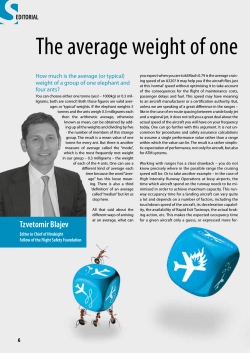
A Mixed Integer Linear Programming Model for the - ATOMIC
OPERATIONAL RESEARCH PRACTICE IN AFRICA (ORPA) 2015 A Mixed Integer Linear Programming Model for the North Atlantic Aircraft Trajectory Planning M. Sbihi, O. Rodionova, D. Delahaye, M. Mongeau ENAC, MAIAA, F-31055 Toulouse, France Univ de Toulouse, IMT, F-31400 Toulouse, France 20-22 April 2015 Abstract This paper discusses the trajectory planning problem for flights in the North Atlantic oceanic airspace (NAT). We develop a mathematical optimization framework in view of better utilizing available capacity by re-routing aircraft. The model is constructed by discretizing the problem parameters. A Mixed integer linear program (MILP) is proposed. Based on the MILP a heuristic to solve real-size instances is also introduced. 1 Context and problem description The North Atlantic oceanic airspace accommodates air traffic between North America and Europe. The major traffic flow takes place in two distinct traffic flows during each 24-hour period due to passenger preference, time zone differences and the imposition of night-time noise curfews at the major airports. The westbound flow departing from Europe in the morning, and the eastbound flow departing from North America in the evening. Radar coverage is not, for most parts, available in the NAT Region. Air Traffic Control (ATC) units monitor the progress of flights on the basis of pilot position reports and uses procedural methods. Such procedures are based on an Organized Track System (OTS) (see [2]). The OTS consists of several, typically 4 to 7, quasi-parallel tracks each of which represents a sequence of great circles joining successive significant waypoints (WPs). The variability of the wind patterns would make a fixed track system unnecessarily penalizing in terms of flight time and consequent fuel usage. As a result, an OTS is set up on a diurnal basis for each of the Westbound and Eastbound flows according to the prevailing winds. Adjacent tracks are separated by 60 Nautical Miles. In vertical direction each track consists of several flight levels spaced by 1000 feet. The construction of OTS ensures vertical and lateral separation between aircraft. The longitudinal (in-track) separation in NAT is assessed in terms of differences in actual and estimated times of arrival at common WPs; and expressed in clock minutes. Current regulations impose large separation minima for aircraft on OTS. The time separation between subsequent aircraft following the same track is 10 minutes. When an aircraft wants to shift from one track to an adjacent track, the separation must be at least 15 minutes with aircraft located on such adjacent track. Due to the high density of traffic on tracks and these large separation standards, the re-routing maneuver inside OTS can rarely be applied. This leads to increasing the length and the duration of the flights, as well as to increasing the congestion in the continental airspace near the exit of the OTS. The transition from present ATC tools to airborne-based systems will allow to reduce significantly the present aircraft separation standards: consecutive aircraft following the same track would be separated by only around 2 minutes, and an aircraft performing a re-routing to the adjacent track would be separated by around 3 minutes from aircraft on this track. Obviously, with such reduced separation standards aircraft will be able to change their tracks more frequently [3]. To show the benefits that can be expected from such a reduction of separation standards, the problem was investigated in [1] using genetic algorithms. The aim of this study is to give an approach based on mixed integer linear programming. 2 Contributions We developed a mathematical optimization framework to better utilize available capacity by re-routing aircraft based on wind conditions and origin/destination of flights. The model is constructed by discretizing the problem parameters. The OTS is represented by a 3D-grid and an MILP path-based formulation is proposed. The program takes (among others things) as input entry and exit tracks and track-entry times of flights. The program then assigns a route to each of these flights explicitly considering separation constraints to minimize the total cruising time within the OTS. The approach can be used with a variety of other aviation-focused metrics. When the number of aircraft increases, a scalability problem rises. The proposed second methodology addresses the scalability problem issue through utilizing a heuristic method. The heuristic recursively defines, and then solves short-term (small-size) subproblems, and partially fixes routes. The heuristic was tested on two test problems based on real air-traffic data and produces near-optimal solutions (typically within 2% of optimality) while standard optimization software fails to solve such instances. Acknowledgements This work has been supported by French National Research Agency (ANR) through JCJC program (project ATOMIC nANR 12-JS02-009-01). References [1] O. Rodionova, M. Sbihi, D. Delahaye, M. Mongeau, North Atlantic Aircraft Trajectory Optimization. IEEE Transactions on Intelligent Transportation Systems DOI: 10.1109/TITS.2014.2312315 (2014). [2] NAT Doc 007, Guidance concerning air navigation in and above the North Atlantic MNPS airspace, 2012th ed., International Civil Aviation Organisation,European and North Atlantic Office of ICAO, (2012). [3] A. Williams, Benefits assessment of reduced separations in North Atlantic Organized Track System, CSSI Inc., Advanced Programs, 400 Virginia Ave. SW, Washington, DC, Tech. Rep., (2005). 2
© Copyright 2025














